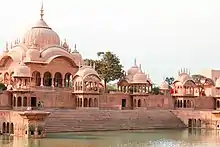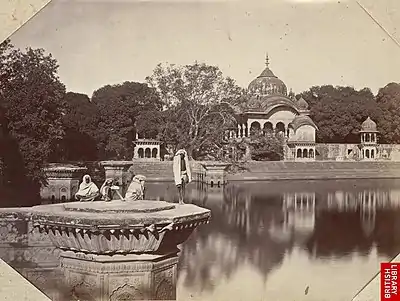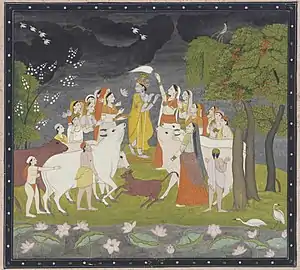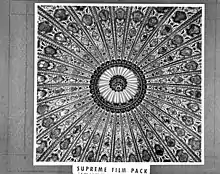Kusum Sarovar
Kusum Sarovar, a historical sandstone monument on the holy Govardhan Hill between Manasi Ganga and Radha Kund in District Mathura of Uttar Pradesh in India, is also the place of Jat ruler Maharaja Suraj Mal's memorial chhatri. Near the monument are the Narada Kund, where Bhakti Sutra verses were written by Narada, and the Sri Radha Vana Bihari Temple.[1][2]

History

It was constructed by the Jat rulers of the Bharatpur. Maharaja Suraj Mal constructed the sarovar and garden for his queen Kishori Rani.
The building, with cenotaphs of the Bharatpur royal family, was built by Maharaja Jawahir Singh, the king of Bharatpur (1707–1763), in honor of his father MahaRaja Suraj Mall in 1764. Members of his family died during the 18th century fighting the British.[1]
It is named for the Kilakinchita Lila legend about female cow herders (gopis) who picked flowers for offerings to the Sun God, Surya Deva for the nearby Surya Deva Temple and met with Krishna and his friend Madhumangala, who vanish and disguise themselves as priests and accept the flowers and sweets at the temple. Sarovar means lake and kusum means flowers.[1]

It was described by Henry George Keene in 1878, "On every side of the reservoir that fronts it, handsome landing-places run out into the still water with deep and wide staircases between; a venerable banyan tree shades the south side, and sends it pendant shoots towards the water… The spot is singular in its repose, its silence, and its irregular charms."[2]
It is one of the sites of the Krishna forest pilgrimage.[2]
Architecture of Suraj Mal's chhatri

Most imposing chhatri is of Mahara Suraj Mal, flanked on either side by two smaller chhatris of his two wives, "Maharani Hansiya" and "Maharani Kishori".[3] Maharaj Suraj Mal is well known for capturing Red Fort in 1754 CE after defetaing the forces of Mughal king Ahmad Shah Bahadur.[4][5] The architecture and carving is in the pierced stone style and the ceiling of cenotaphs are adorned with the beautiful painting of life of lord Krishna and Maharajs Suraj Mal's court.[6][3]
The principle tomb is 57 square feet in area.[7] On the upper level are three tombs. The main tomb of Maharaja Surajmal has beautiful paintings on its ceiling depicting the pastimes of Krishna and the lotus feet of Krishna engraved on the floor. There are also some paintings of MahaRaja SurajMal in his court. The other tombs are those of his two queens, Kishori and Hansiya.[2] There are beautiful paintings on the ceiling of these two tombs. The lofty terrace upon which they stand is 460 feet in length, with a long shallow pavilion serving as a screen at each end, and nine two-stories kiosks of varying outline to relieve the front. Attached to Rani Hansiya's monument is a smaller one in commemoration of a faithful attendant. Behind is an extensive garden. In front, at the foot of the terrace, below a broad flight of steps, is an artificial lake.[2][8]
References
- Dev Prasad (27 January 2015). Krishna: A Journey through the Lands & Legends of Krishna. Jaico Publishing House. pp. PT 147. ISBN 978-81-8495-170-7.
- Henry George Keene (1878). A Handbook for Visitors to Agra and Its Neighbourhood. Thacker, Spink. pp. 71–72.
- D. Anand, 1992, Krishna: The Living God of Braj, Page 56.
- Jat Kingdom of Bharatpur
- "Haryana Revenue Gazeteer of Gurgaon 1910, Section B - History" (PDF). Archived from the original (PDF) on 9 October 2016. Retrieved 30 January 2019.
- Madan Prasad Bezbaruah, Dr. Krishna Gopal, Phal S. Girota, 2003, Fairs and Festivals of India: Chandigarh, Delhi, Haryana, Himachal Pradesh, Jammu and Kashmir, Punjab, Rajasthan, Uttaranchal, Uttar Pradesh, p. 480-494.
- Frederic Salmon Growse (1883). Mathurá: A District Memoir. New Order Book Company. pp. 307–308.
- Frederic Salmon Growse (1883). Mathurá: A District Memoir. New Order Book Company. p. 40.
Further reading
- A. W. Entwistle (1987). "Kusum Sarovar". Braj, centre of Krishna pilgrimage. E. Forsten.
External links
![]() Media related to Kusum Sarovar at Wikimedia Commons
Media related to Kusum Sarovar at Wikimedia Commons